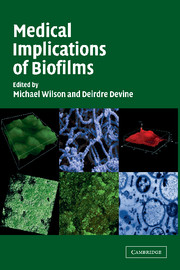Book contents
- Frontmatter
- Contents
- Preface
- List of Contributors
- PART ONE INTRODUCTORY CHAPTERS
- PART TWO BIOFILMS ON PROSTHETIC DEVICES
- 4 Animal Models of Orthopaedic Implant Infection
- 5 Intravascular-Catheter-Related Infections
- 6 Molecular Basis of Biofilm Formation by Staphylococcus epidermidis
- 7 Biofilm Complications of Urinary Tract Devices
- PART THREE ORAL BIOFILMS
- PART FOUR BIOFILMS ON SHEDDING SURFACES
- Index
- References
5 - Intravascular-Catheter-Related Infections
Published online by Cambridge University Press: 23 November 2009
- Frontmatter
- Contents
- Preface
- List of Contributors
- PART ONE INTRODUCTORY CHAPTERS
- PART TWO BIOFILMS ON PROSTHETIC DEVICES
- 4 Animal Models of Orthopaedic Implant Infection
- 5 Intravascular-Catheter-Related Infections
- 6 Molecular Basis of Biofilm Formation by Staphylococcus epidermidis
- 7 Biofilm Complications of Urinary Tract Devices
- PART THREE ORAL BIOFILMS
- PART FOUR BIOFILMS ON SHEDDING SURFACES
- Index
- References
Summary
INTRODUCTION
The past few decades have witnessed the advent of many medical advancements, which undoubtedly have aided health care professionals and ameliorated the suffering of many critically ill patients. Among these advancements are intravascular catheters, which have become indispensable for the administration of medications, especially chemotherapeutic agents, intravenous antibiotics, blood products, parenteral nutritional solutions, and fluids; for monitoring critically ill patients haemodynamically; and for providing access for haemodialysis (Flowers et al., 1989). The use of such devices is associated with an increased risk for catheter-related infections, such as local catheter site infection, thrombophlebitis, catheter-related bloodstream infections (CR-BSI), endocarditis, metastatic infections such as osteomyelitis, arthritis, endophthalmitis, and distant organ abscesses (Arnow, Quimosing, and Beach, 1993). Our understanding of the process that leads to CR-BSI has evolved over the years, and now the role of bacterial biofilms in this process is certainly undeniable.
Bacterial biofilms have always existed ubiquitously in the world around us. Costerton and Stewart describe some examples: ‘the slippery coating on a rock in a stream, dental plaque (which most of us confront daily), and the slime that inevitably materializes inside a flower vase after two or three days’ (Costerton and Stewart, 2001). In addressing the medical implications of biofilms as they relate to intravascular-catheter-related infections, we will begin by defining the magnitude of the problem of catheter-related infections, followed by addressing the role of biofilms in the pathogenesis of CR-BSI. Finally, we will review some strategies to prevent biofilm formation on central venous catheters (CVC).
- Type
- Chapter
- Information
- Medical Implications of Biofilms , pp. 86 - 109Publisher: Cambridge University PressPrint publication year: 2003



